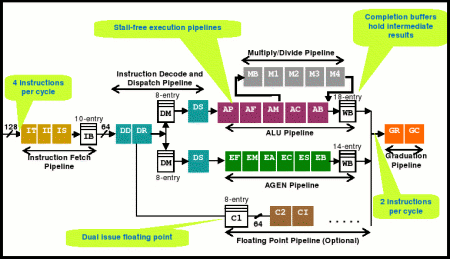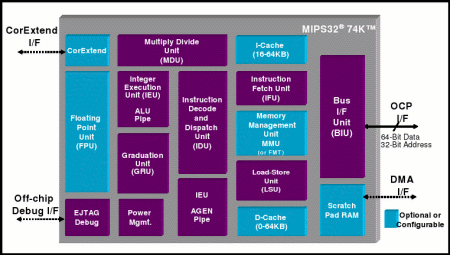High-end MIPS CPU gains embedded Linux support
Oct 12, 2007 — by LinuxDevices Staff — from the LinuxDevices Archive — 19 viewsTimeSys has extended its online embedded Linux customization service, adding support for the newest and fastest 32-bit processor core from MIPS Inc. “LinuxLink” support is available now for the MIPS 74K core, touted as the first synthesizable core capable of clocking over 1GHz, according to the company.
MIPS unveiled the 74K in May of this year, claiming the core could handle “worst case” clock speeds of 1.04GHz, when synthesized into SoCs (system-on-chip processors) built on 65nm TSMC process technology. Target applications include plugged-in, high-volume consumer devices, such as TVs, set-top boxes, networked DVD players/recorders, and broadband access equipment.
Additionally, the core's optional dual-issue FPU (floating point pipeline) and optional DSP ASE (digital signal processing application-specific engine) functions suit media-intensive applications like HD DVD, H.264, 802.11n, WiMAX, and Blu-ray Disc, MIPS says.

MIPS 74K pipeline flow
(Click to enlarge)
Support for fast clocking appears to come in part from an exceptionally long pipeline with some 17 stages — twice the number in typical embedded cores, and more even than Intel's Pentium M and Core 2 Duo architectures. To keep the pipe full, the 74K can handle up to 64K each of instruction and data cache, although 32K is standard.

74K function block diagram
(Click to enlarge)
Additional 74K features include an optional “scratch pad RAM” (which may diminish clock), on-chip EJTAG debug unit, built-in power management processor, and dedicated processing units for data loading/storing, instruction fetching, and “decode and dispatch.” The core also offers a “significant” reduction in power consumption compared to earlier cores, despite its long pipeline, according to MIPS.
MIPS claims the extra performance attainable by clocking the 74K at 1GHz or better will enable SoC designers to do without expensive IP libraries, instead relying on “generic standard cells, memories, and EDA design flows.” Additionally, the core is said to be compatible with designers' existing hardware infrastructure for earlier MIPS cores, including the 24K, 24KE, and 34K. It's supported by EDA (electronic design automation) tools from Cadence Design, Magma Design, Mentor Graphics, and Synopsys, and core debug tools from FS2.
MIPS says the 74K core was licensed by Broadcom in January, and Infineon in July. Meanwhile, MIPS competitor ARM has also been touting core designs capable of clocking quite high, and delivering “multi-issue” or “superscalar” performance in which multiple instructions may be executed during each clock cycle. ARM's superscalar cores include the Cortex-A8 — also licensed by Broadcom — and the just-announced multi-core capable Cortex-A9.
TimeSys's 74K LinuxLink
TimeSys says its LinuxLink for the 74K core helps subscribers build their own custom Linux software platforms for chips based on the processor. Touted benefits include “ongoing access” to the “most up-to-date embedded Linux resources throughout every stage of development.”
Additional touted features include:
- Reference distro for MIPS Malta development board
- “Optimized” kernel with integrated drivers
- “Complete” RFS (root filesystem)
- Tools
- The Linux kernel optimized for the MIPS32 74K core
- Repository of source and binary cross-compiled packages
- An IDE (integrated development environment)
- Testing and profiling tools
- Cross-compiling tools
- Online environment for collaborative team design
- Online support forums and interactive support
TimeSys CEO Atul Bansal stated, “The MIPS32 74K core family provides compelling options for building high-end devices like cable set-top boxes and advanced network appliances. Using LinuxLink, customers can build a customized Linux platform.”
Availability
The 74K core is shipping now, with silicon from MIPS customers likely to sample later this year or early next. TimeSys's LinuxLink subscription for the 74K architecture is available now. Pricing was not disclosed.
This article was originally published on LinuxDevices.com and has been donated to the open source community by QuinStreet Inc. Please visit LinuxToday.com for up-to-date news and articles about Linux and open source.